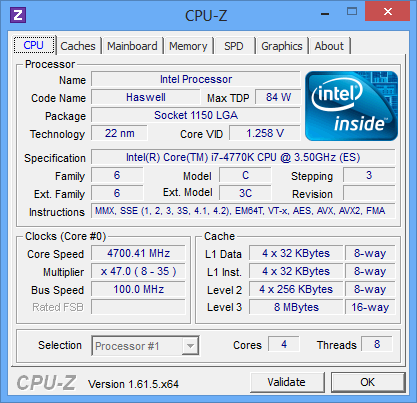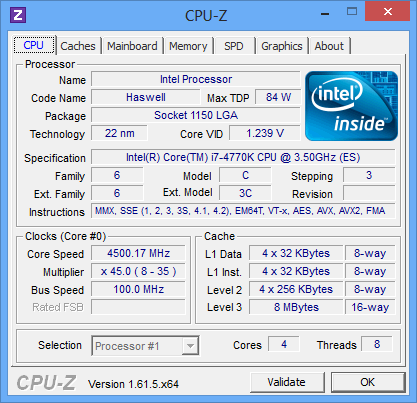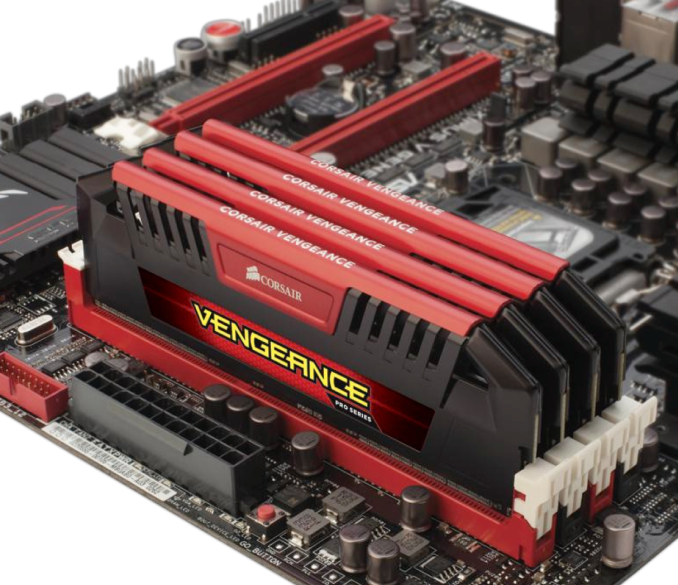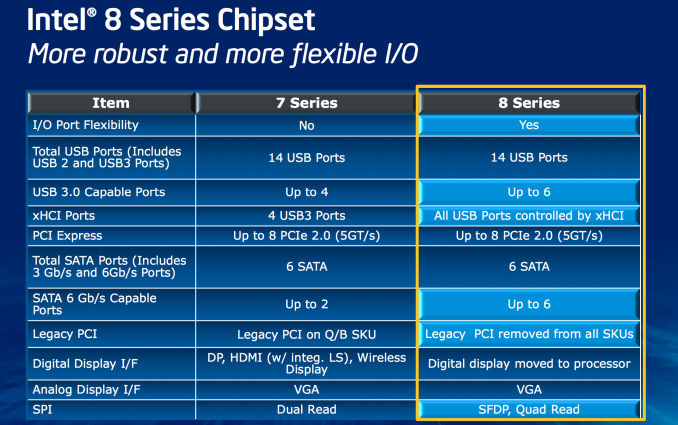The Haswell Review: Intel Core i7-4770K & i5-4670K Tested
by Anand Lal Shimpi on June 1, 2013 10:00 AM ESTMemory
Haswell got an updated memory controller that’s supposed to do a great job of running at very high frequencies. Corsair was kind enough to send over some of its Vengeance Pro memory with factory DDR3-2400 XMP profiles. I have to say, the experience was quite possibly the simplest memory overclocking I’ve ever encountered. Ivy Bridge was pretty decent at higher speeds, but Haswell is a different beast entirely.
Although I used DDR3-2400 for most of my testing, Corsair’s Vengeance Pro line is available in frequencies rated all the way up to 2933MHz.
Platform
Haswell features a new socket (LGA-1150). Fundamental changes to power delivery made it impossible to maintain backwards compatibility with existing LGA-1155 sockets. Alongside the new socket comes Intel’s new 8-series chipsets.
At a high level the 8-series chipsets bring support for up to six SATA 6Gbps and USB 3.0. It’s taken Intel far too long to move beyond two 6Gbps SATA ports, so this is a welcome change. With 8-series Intel also finally got rid of legacy PCI support.
Overclocking
Despite most of the voltage regulation being moved on-package, motherboards still expose all of the same voltage controls that you’re used to from previous platforms. Haswell’s FIVR does increase the thermal footprint of the chip itself, which is why TDPs went up from 77W to 84W at the high-end for LGA-1150 SKUs. Combine higher temperatures under the heatspreader with a more mobile focused chip design, and overclocking is going to depend on yield and luck of the draw more than it has in the past.
Haswell doesn’t change the overclocking limits put in place with Sandy Bridge. All CPUs are frequency locked, however K-series parts ship fully unlocked. A new addition is the ability to adjust BCLK to one of three pre-defined straps (100/125/167MHz). The BCLK adjustment gives you a little more flexibility when overclocking, but you still need a K-SKU to take advantage of the options.


In terms of overclocking success on standard air cooling you should expect anywhere from 4.3GHz - 4.7GHz at somewhere in the 1.2 - 1.35V range. At the higher end of that spectrum you need to be sure to invest in a good cooler as you’re more likely to bump into thermal limits if you’re running on stable settings.

















210 Comments
View All Comments
Khato - Sunday, June 2, 2013 - link
Based on the published Haswell 4C GT2 die shot I believe that your estimates for the graphics area are quite high. It's relatively simple to derive the graphics area on 4C GT2 now that we know the total die size - should be somewhere in the vicinity of 58mm^2. Double that and you get 116mm^2 for GT3.As for the remaining 29mm^2 delta between 4C GT2 and 4C GT3 die sizes... I'd chalk that up to both inefficiencies due to going with a more square die instead of the long and skinny that's been with us since SNB and the extra logic/IOs necessary for the eDRAM L4.
Regardless, there's no question that the 174mm^2 figure for GT3 is incorrect as the 4 cores, associated L3, and system agent on the 4C GT2 die take up approximately 119mm^2, and adding 174mm^2 to that would yield a 293mm^2 die size.
Bobsama - Sunday, June 2, 2013 - link
I too am on a Core i7-950. I bought it in April 2012. If this system died and I was building anew, I'd probably do it--I'd probably grab an i7-4770K. But for $500, notta chance!LeetMiniWheat - Sunday, June 2, 2013 - link
Would have been nice to see some actual CPU-bound games, like Skyrim. Or something low res to take the load completely off the GPU.roltzje - Sunday, June 2, 2013 - link
It doesn't take a genius to figure whats going on here. Competition spurs innovation. There is no competition for mid-high end desktop processors, or even laptop processors really. AMD only keeps up with mid range because they have to set very high clocks on their inferior architecture.Where the competition is is in mobile. Smartphones and tablets. By moving Haswell down this generation, Intel is getting themselves closer to be a true competitor in that space. This year we should see a power and battery life combination that ARM cannot reach.
There are also huge gains for gaming and gaming laptops. A 14-15" mid-ranger cost $500 with Iris graphics should be able to run most games decently now without all-minimum settings. Especially given that the PS4 and XBO are running x86 low to mid range graphics, I can easily see Haswell notebooks keeping up, especially Iris pro laptops, which I would assume can come in under $1000 and in relatively slim form factors.
deepblue08 - Sunday, June 2, 2013 - link
I think they should benchmarks this new CPU with 2-3GPUs. I don't think 1 video card is enough to really test the strength of new cpus, which is why the difference between ivy bridge and haswell is so small. Give them 2-3 GPUs to work with and see if they can really step-up.Yahma - Sunday, June 2, 2013 - link
YAWN... with no competition from AMD, Haswell offers none to just a few % improvement over the previous generation (depending on who's benchmarks you believe), higher power consumption, and fewer features (ie. no virtualization extensions on the higher end models) all at a higher price that requires one to purchase a new motherboard.... No Thanks!just4U - Sunday, June 2, 2013 - link
That was covered in a previous article.. it was established that the 3770K was the go to cpu for multiple video card systems. (altho.. I'd say this would do in a pinch as would the previous 2600/2700K)Yahma - Sunday, June 2, 2013 - link
YAWN... with no competition from AMD, Haswell offers none to just a few % improvement over the previous generation (depending on who's benchmarks you believe), higher power consumption, and fewer features (ie. no virtualization extensions on the higher end models) all at a higher price that requires one to purchase a new motherboard.... No Thanks!mcbowler - Sunday, June 2, 2013 - link
thanks for posting "CPU Performance: Going Even Further Back" almost twice as fast as my i5 750. I just might upgrade when the NCASE M1 is available.araczynski - Sunday, June 2, 2013 - link
either way, should be a serious boost in power to my aging E8500 :)